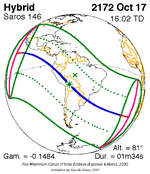Solar eclipse of June 8, 1956
| Solar eclipse of June 8, 1956 | |
|---|---|
| Type of eclipse | |
| Nature | Total |
| Gamma | −0.8934 |
| Magnitude | 1.0581 |
| Maximum eclipse | |
| Duration | 285 s (4 min 45 s) |
| Coordinates | 40°48′S 140°42′W / 40.8°S 140.7°W |
| Max. width of band | 429 km (267 mi) |
| Times (UTC) | |
| Greatest eclipse | 21:20:39 |
| References | |
| Saros | 146 (24 of 76) |
| Catalog # (SE5000) | 9412 |
A total solar eclipse occurred on June 8–9, 1956. A solar eclipse occurs when the Moon passes between Earth and the Sun, thereby totally or partly obscuring the image of the Sun for a viewer on Earth. A total solar eclipse occurs when the Moon's apparent diameter is larger than the Sun's, blocking all direct sunlight, turning day into darkness. Totality occurs in a narrow path across Earth's surface, with the partial solar eclipse visible over a surrounding region thousands of kilometres wide. It began near sunrise over New Zealand on June 9 (Saturday), and ended west of South America on June 8 (Friday).
More details[edit]
Eclipse Magnitude: 1.05810
Eclipse Obscuration: 1.11958
Gamma: -0.89341
Saros Series: 146th (24 of 76)
Greatest Eclipse: 08 Jun 1956 21:20:07.7 UTC (21:20:39.3 TD)
Ecliptic Conjunction: 08 Jun 1956 21:29:07.4 UTC (21:29:39.0 TD)
Equatorial Conjunction: 08 Jun 1856 21:20:45.9 UTC (21:21:17.5 TD)
Sun right ascension: 5.13
Moon right ascension: 5.13
Earth's shadow right ascension: 17.13
Sun declination: 22.9
Moon declination: 22
Earth's shadow declination: -22.9
Sun diameter: 1890.4 arcseconds
Moon diameter: 1985.8 arcseconds
Path Width at Greatest Eclipse: 428.7 km (266.4 mi)
Path Width at Greatest Duration: 428.7 km (266.4 mi)
Central Duration at Greatest Eclipse: 4 minutes, 44.85 seconds
Central Duration at Greatest Duration: 4 minutes, 44.86 seconds
Related eclipses[edit]
Solar eclipses of 1953–1956[edit]
This eclipse is a member of a semester series. An eclipse in a semester series of solar eclipses repeats approximately every 177 days and 4 hours (a semester) at alternating nodes of the Moon's orbit.[1]
Note: Partial solar eclipse of February 14, 1953 and August 9, 1953 belong to the last lunar year set.
| Solar eclipse series sets from 1953 to 1956 | ||||
|---|---|---|---|---|
| Descending node | Ascending node | |||
| Saros | Map | Saros | Map | |
| 116 |  1953 July 11 Partial |
121 |  1954 January 5 Annular | |
| 126 |  1954 June 30 Total |
131 |  1954 December 25 Annular | |
| 136 |  1955 June 20 Total |
141 |  1955 December 14 Annular | |
| 146 |  1956 June 8 Total |
151 |  1956 December 2 Partial | |
Saros 146[edit]
It is a part of Saros cycle 146, repeating every 18 years, 11 days, containing 76 events. The series started with partial solar eclipse on September 19, 1541. It contains total eclipses from May 29, 1938, through October 7, 2154, hybrid eclipses from October 17, 2172, through November 20, 2226, and annular eclipses from December 1, 2244, through August 10, 2659. The series ends at member 76 as a partial eclipse on December 29, 2893. The longest duration of totality was 5 minutes, 21 seconds on June 30, 1992.
| Series members 21-37 occur between 1901 and 2200: | ||
|---|---|---|
| 21 | 22 | 23 |
 May 7, 1902 |
 May 18, 1920 |
 May 29, 1938 |
| 24 | 25 | 26 |
 June 8, 1956 |
 June 20, 1974 |
 June 30, 1992 |
| 27 | 28 | 29 |
 July 11, 2010 |
 July 22, 2028 |
 August 2, 2046 |
| 30 | 31 | 32 |
 August 12, 2064 |
 August 24, 2082 |
 September 4, 2100 |
| 33 | 34 | 35 |
 September 15, 2118 |
 September 26, 2136 |
 October 7, 2154 |
| 36 | 37 | |
 October 17, 2172 |
 October 29, 2190 | |
Notes[edit]
- ^ van Gent, R.H. "Solar- and Lunar-Eclipse Predictions from Antiquity to the Present". A Catalogue of Eclipse Cycles. Utrecht University. Retrieved 6 October 2018.
References[edit]
- Earth visibility chart and eclipse statistics Eclipse Predictions by Fred Espenak, NASA/GSFC




